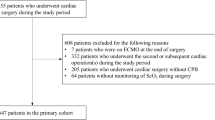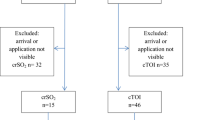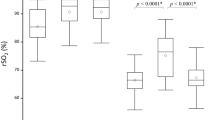Abstract
Objective
To evaluate the relationship between the cerebral tissue oxygenation index measured by near-infrared spectroscopy and central venous oxygen saturation (SvO2) after corrective surgery of congenital heart defects in children.
Design
Prospective observational clinical study.
Setting
A tertiary neonatal and paediatric intensive care unit for paediatric cardiology.
Patients
Neonates and children consecutively admitted to the paediatric cardiology intensive care unit after corrective surgery of non-cyanotic congenital heart defects.
Measurements and results
Forty-three children were studied. Cerebral tissue oxygenation index, measured non-invasively by near-infrared spectroscopy, was compared to SvO2, measured by a catheter placed in the right atrium, and to haemodynamic and respiratory parameters. Pearson’s correlation coefficients and p values were calculated. Simultaneously measured values for SvO2 (62.2±9.8%, 39.8–80.4%) and cerebral tissue oxygenation index (56.7±8.8%, 35.8–71.2%) showed a significant correlation (r=0.52, p<0.001).
Conclusion
Cerebral tissue oxygenation index and SvO2 are not interchangeable parameters, but cerebral tissue oxygenation index reflects the haemodynamic influence on cerebral oxygenation after cardiovascular surgery. Further work is necessary to confirm the clinical role of continuous non-invasive measurement of cerebral tissue oxygenation index with regard to the variations of global systemic oxygen consumption after cardiac surgery in children.

Similar content being viewed by others
References
Tweddell JS, Hoffman GM (2002) Postoperative management in patients with complex congenital heart disease. Semin Thorac Cardiovasc Surg Pediatr Card Surg Annu 5:187–205
Shaaban-Ali M, Harmer M, Latto I (2001) Jugular bulb oximetry during cardiac surgery. Anaesthesia 56:24–37
Jobsis FF (1977) Noninvasive, infrared monitoring of cerebral and myocardial oxygen sufficiency and circulatory parameters. Science 198:1264–1267
Wahr JA, Tremper KK, Samra S, Delpy DT (1996) Near-infrared spectroscopy: theory and applications. J Cardiothorac Vasc Anesth 10:406–418
Adcock LM, Wafelman LS, Hegemier S, Moise AA, Speer ME, Contant CF, Goddard-Finegold J (1999) Neonatal intensive care applications of near-infrared spectroscopy. Clin Perinatol 26:893–903
Schulz G, Weiss M, Bauersfeld U, Teller J, Haensse D, Bucher HU, Baenziger O (2002) Liver tissue oxygenation as measured by near-infrared spectroscopy in the critically ill child in correlation with central venous oxygen saturation. Intensive Care Med 28:184–189
Fortune PM, Wagstaff M, Petros AJ (2001) Cerebro-splanchnic oxygenation ratio (CSOR) using near infrared spectroscopy may be able to predict splanchnic ischaemia in neonates. Intensive Care Med 27:1401–1407
Abdul-Khaliq H, Troitzsch D, Schubert S, Wehsack A, Bottcher W, Gutsch E, Hubler M, Hetzer R, Lange PE (2002) Cerebral oxygen monitoring during neonatal cardiopulmonary bypass and deep hypothermic circulatory arrest. Thorac Cardiovasc Surg 50:77–81
Matcher SJ, Kirkpatrick P, Nahid K, Cope M, Delpy DT (1995) Absolute quantification methods in tissue near infrared spectroscopy. Proc SPIE 2389:486–495
Suzuki S, Takasaki S, Ozaki T, Kobayashi Y (1999) A tissue oxygenation monitor using NIR spatially resolved spectroscopy. Proc SPIE 3579:144–145
Rigg CD, Clutton-Brock TH (1997) Near-infrared spectroscopy changes during hypothermic circulatory arrest with retrograde cerebral perfusion. Anaesthesia 52:356–359
Nollert G, Jonas RA, Reichart B (2000) Optimizing cerebral oxygenation during cardiac surgery: a review of experimental and clinical investigations with near infrared spectrophotometry. Thorac Cardiovasc Surg 48:247–253
Nollert G, Shin’oka T, Jonas RA (1998) Near-infrared spectrophotometry of the brain in cardiovascular surgery. Thorac Cardiovasc Surg 46:167–175
Von Siebenthal K, Bernert G, Casaer P (1992) Near-infrared spectroscopy in newborn infants. Brain Dev 14:135–143
Du Plessis AJ (1995) Near-infrared spectroscopy for the in vivo study of cerebral hemodynamics and oxygenation. Curr Opin Pediatr 7:632–639
Weiss M, Schulz G, Fasnacht M, Balmer C, Fischer JE, Gerber AC, Bucher HU, Baenziger O (2002) Transcutaneously measured near-infrared spectroscopic liver tissue oxygenation does not correlate with hepatic venous oxygenation in children. Can J Anesth 49:824–829
Daubeney PE, Pilkington SN, Janke E, Charlton GA, Smith DC, Webber SA (1996) Cerebral oxygenation measured by near-infrared spectroscopy: comparison with jugular bulb oximetry. Ann Thorac Surg 61:930–934
Abdul-Khaliq H, Troitzsch D, Berger F, Lange PE (2000) Regional transcranial oximetry with near infrared spectroscopy (NIRS) in comparison with measuring oxygen saturation in the jugular bulb in infants and children for monitoring cerebral oxygenation (in German). Biomed Tech (Berl) 45:328–332
Ter Minassian A, Poirier N, Pierrot M, Menei P, Grany JC, Ursino M, Beydon L (1999) Correlation between cerebral oxygen saturation measured by near-infrared spectroscopy and jugular oxygen saturation in patients with severe closed head injury. Anesthesiology 91:985–990
Lewis SB, Myburgh JA, Thornton EL, Reilly PL (1996) Cerebral oxygenation monitoring by near-infrared spectroscopy is not clinically useful in patients with severe closed-head injury: a comparison with jugular venous bulb oximetry. Crit Care Med 24:1334–1338
Kirkpatrick PJ, Smielewski P, Czosnyka M, Menon DK, Pickard JD (1995) Near-infrared spectroscopy use in patients with head injury. J Neurosurg 83:963–970
Ali MS, Harmer M, Vaughan RS, Dunne JA, Latto IP (2001) Spatially resolved spectroscopy (NIRO-300) does not agree with jugular bulb oxygen saturation in patients undergoing warm bypass surgery. Can J Anaesth 48:497–501
Quaresima V, Sacco S, Totaro R, Ferrari M (2000) Noninvasive measurement of cerebral hemoglobin oxygen saturation using two near infrared spectroscopy approaches. J Biomed Opt 5:201–205
Grubhofer G, Lassnigg A, Manlik F, Marx E, Trubel W, Hiesmayr M (1997) The contribution of extracranial blood oxygenation on near-infrared spectroscopy during carotid thrombendarterectomy. Anaesthesia 52:116–120
Fearn SJ, Chant HJ, Picton AJ, Mortimer AJ, McCollum CN (1997) The contribution of extracranial blood oxygenation on near-infrared spectroscopy during carotid endarterectomy. Anaesthesia 52:704–705
Chan MT, Lam JM, Gomersall CD (1997) The contribution of extracranial blood oxygenation on near infrared spectroscopy during carotid endarterectomy. Anaesthesia 52:705–706
Germon TJ, Young AE, Manara AR, Nelson RJ (1995) Extracerebral absorption of near infrared light influences the detection of increased cerebral oxygenation monitored by near infrared spectroscopy. J Neurol Neurosurg Psychiatry 58:477–479
Al-Rawi PG, Smielewski P, Kirkpatrick PJ (2001) Evaluation of a near-infrared spectrometer (NIRO 300) for the detection of intracranial oxygenation changes in the adult head. Stroke 32:2492–2500
Miller HC, Brown DJ, Miller GAH (1974) Comparison of formulae used to estimate oxygen saturation of mixed venous blood from caval samples. Br Heart J 36:446–451
Acknowledgement
The authors would like to thank Anne Gale of the Deutsches Herzzentrum Berlin for editorial assistance.
Author information
Authors and Affiliations
Corresponding author
Rights and permissions
About this article
Cite this article
Nagdyman, N., Fleck, T., Barth, S. et al. Relation of cerebral tissue oxygenation index to central venous oxygen saturation in children. Intensive Care Med 30, 468–471 (2004). https://doi.org/10.1007/s00134-003-2101-8
Received:
Accepted:
Published:
Issue Date:
DOI: https://doi.org/10.1007/s00134-003-2101-8




